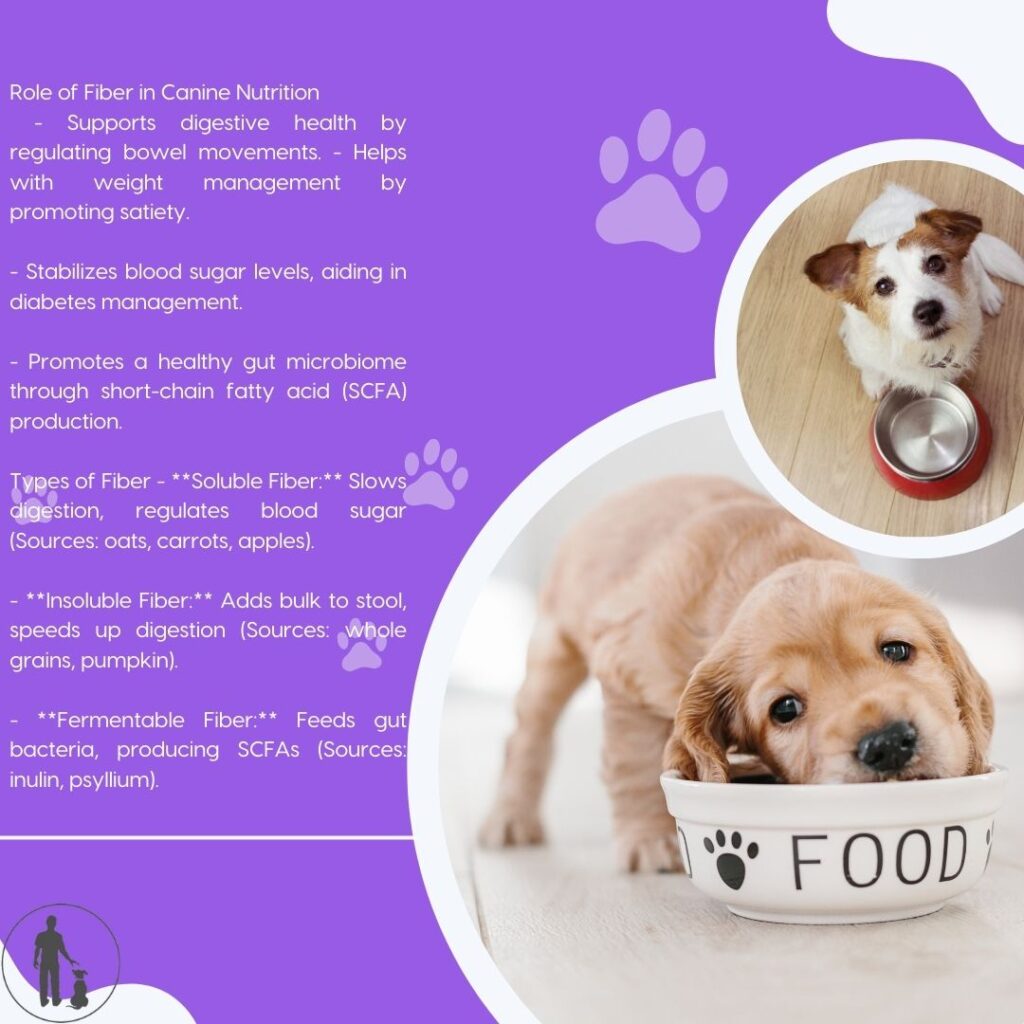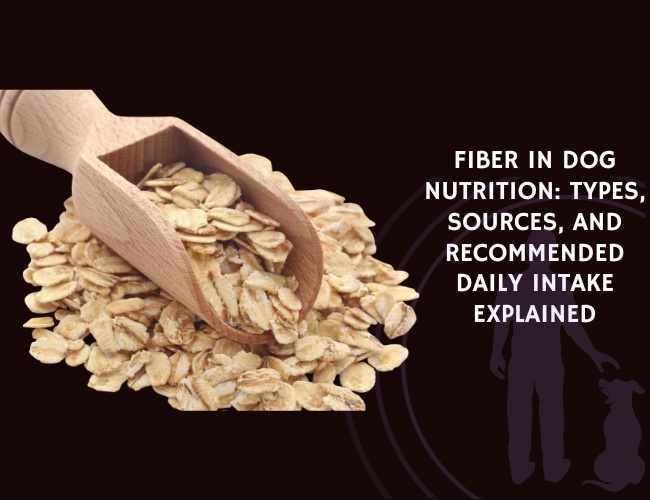Introduction to Dietary Fiber
Definition of Fiber
Fiber is a type of carbohydrate found in plant-based foods. Unlike other carbohydrates, which are broken down by a dog’s digestive enzymes, fiber is indigestible. This means it travels through the digestive system relatively intact, contributing to various health benefits along the way. By understanding the fundamental role of fiber in canine nutrition, dog owners can better cater to their pet’s digestive health and overall well-being.
Fundamental Role in Canine Digestive Health
Fiber’s foremost contribution is to digestive health. It plays a vital role in both regulating digestion and maintaining a balanced healthy gut. Specifically, fiber helps in:
- Preventing Constipation: By adding bulk to the stool, fiber facilitates easier and more regular bowel movements.
- Managing Diarrhea: Fiber can absorb excess water in the bowel, helping to form a more solid stool and mitigating issues related to diarrhea.
- Supporting a Healthy Gut Microbiome: The presence of fiber encourages the growth of beneficial gut bacteria, which in turn supports overall digestive health.
- Regulating Digestion: The steady movement of food through the digestive system is supported by fiber, preventing digestive disorders and ensuring nutrient absorption efficiency.
Importance in Regular Bowel Movements and Gut Health
Regular bowel movements are essential for a dog’s overall gut health. Fiber ensures that these movements are not just regular but also comfortable for the pet, minimizing any strain or potential intestinal distress. Consistent fiber intake can:
- Promote Regular Defecation: Fiber’s bulking effect on stool helps maintain a regular defecation schedule.
- Prevent Digestive Discomfort: Adequate fiber levels can help avoid issues such as bloating and flatulence, making canine digestion smoother and more efficient.
- Express Anal Glands Naturally: Fiber helps naturally express the dog’s anal glands during defecation, thereby reducing the risk of impaction and related complications.
By maintaining gut health and supporting regular bowel movements, fiber ensures that dogs remain comfortable and healthy. Additionally, the presence of fiber in the diet can significantly reduce the risk of colon-related health issues and improve the gut environment’s overall functionality.
Understanding the role of dietary fiber sets the stage for exploring its various types and the specific health benefits it offers, which we will discuss next.
Types of Dietary Fiber
Dietary fiber comes in various forms, each playing a unique role in canine digestion and overall health. Let’s explore the different types of dietary fiber and understand their specific functions.
Soluble Fiber
Soluble fiber is characterized by its ability to dissolve in water, forming a gel-like substance. This gelatinous texture slows down digestion, which can be beneficial for regulating blood sugar levels and improving nutrient absorption. Key sources of soluble fiber include oats, barley, legumes, apples, and carrots. This type of fiber also helps in maintaining healthy cholesterol levels and can aid in the management of diabetes by stabilizing glucose absorption after meals.
Insoluble Fiber
On the other hand, insoluble fiber does not dissolve in water. Instead, it adds bulk to the stool and helps speed up the passage of food through the digestive tract. By promoting quicker digestive transit, insoluble fiber is highly effective in preventing constipation and ensuring regular bowel movements. Some common sources of insoluble fiber include whole grains, vegetables, pumpkin, and brown rice. This type of fiber is essential for dogs who need help with maintaining healthy digestion and regularity.
Fermentable vs Non-Fermentable Fiber
Dietary fibers can also be classified as fermentable and non-fermentable, based on their interaction with gut bacteria.
Fermentable Fiber
Fermentable fibers are partially broken down by the bacteria in the gut, producing short-chain fatty acids (SCFAs) as a byproduct. These SCFAs are vital for colon health as they nourish the cells lining the colon and may reduce the risk of colon cancer. Examples of fermentable fibers include certain soluble fibers such as inulin and psyllium.
Non-Fermentable Fiber
Non-fermentable fibers, in contrast, are not broken down by gut bacteria. Instead, they pass through the digestive system largely intact, adding bulk to the stool and aiding in regular bowel movements. This type of fiber is helpful in managing conditions that benefit from increased stool bulk, such as anal gland issues, by promoting natural expression during defecation.
While each type of fiber has its unique benefits, a balanced inclusion of both soluble and insoluble fibers can contribute to optimal digestive health and overall well-being for dogs.
As we move forward, it’s important to keep these distinctions in mind to better understand how fiber can be utilized effectively within a balanced canine diet.
Health Benefits of Fiber
Support for Digestive Health and Regular Bowel Movements
Dietary fiber plays a fundamental role in canine digestive health, supporting regular bowel movements and overall gut function. Fiber helps to add bulk to a dog’s stool, which promotes steady, healthy defecation. This aids in preventing both constipation and diarrhea, ensuring a balanced digestive system. By maintaining this regularity, fiber also assists in naturally expressing a dog’s anal glands during defecation, minimizing the risk of impaction and discomfort.
Additionally, fiber aids in the management of digestive disorders such as Irritable Bowel Disease (IBD) and colitis. It does so by absorbing excess water in the intestines, stabilizing digestive transit, and aiding in the maintenance of a healthy gastrointestinal environment. This makes it an essential nutrient in promoting consistent and comfortable bowel habits for your dog.
Role in Weight Management and Blood Sugar Regulation
Fiber is a helpful tool in canine weight management and blood sugar control. High-fiber foods tend to be lower in calories, which means they can help manage a dog’s weight without compromising on satiety or nutrition. Fiber expands in the stomach, leading to an increased feeling of fullness. This increased satiety reduces the likelihood of overeating and unnecessary weight gain, making fiber an effective component of a weight loss diet for obese dogs.
Moreover, soluble fiber slows the absorption of glucose in the bloodstream, leading to more stable blood sugar levels. This is especially beneficial for dogs diagnosed with diabetes or those at risk of developing blood sugar irregularities. By modulating the absorption rate, fiber helps to avoid postprandial blood sugar spikes, thereby offering a gentle, sustained release of energy throughout the day.
Gut Microbiome Support and Colon Health Benefits
Fiber’s benefits extend beyond digestion, playing a crucial role in the overall health of a dog’s gut microbiome. Fermentable fibers, in particular, serve as prebiotics – they feed beneficial gut bacteria and promote a balanced microbiome. This can lead to a reduction in the risk of gastrointestinal diseases and a bolstered immune system.
Fermentable fibers are partially broken down by gut bacteria, producing Short-Chain Fatty Acids (SCFAs). SCFAs are essential for maintaining a healthy colon as they provide energy for colon cells and help reduce inflammation. This process supports colon health and can even lower the risk of colon cancer over time.
By nurturing a healthy gut microbiome, fiber aids in promoting digestive health, strengthening the immune system, and ensuring that your dog’s digestive tract functions smoothly.
Maintaining an appropriate fiber intake is essential for dogs’ overall health. Regular, well-formed stools and the absence of bloating or excessive flatulence are good indicators of proper fiber consumption. As we continue to understand the robust role of fiber in canine diets, it’s evident that a well-balanced diet including the right types and amounts of fiber can provide numerous health benefits for our canine companions.
Natural Sources of Fiber
Understanding the natural sources of fiber can immensely benefit your dog’s diet, leading to better digestion, weight management, and overall health. Let’s dive into some of the most effective and nutritious sources of dietary fiber for your canine companion:
Vegetables
Vegetables are a fantastic source of both soluble and insoluble fiber, essential for maintaining your dog’s digestive health.
- Pumpkin: Pumpkins are rich in soluble fiber and are excellent for promoting digestive health. This nutrient-dense vegetable helps regulate bowel movements and is particularly useful for dogs experiencing constipation or diarrhea.
- Carrots: Carrots provide a balance of both soluble and insoluble fiber. They are crunchy, low in calories, and can be an excellent chewy treat for your dog while supporting their digestive health.
- Green Beans: Low in calories and high in fiber, green beans are a great option for adding bulk to your dog’s stool, which can help maintain their digestive transit and proper bowel movement regularity.
Fruits
Fruits are another great, natural source of fiber but should be given in moderation to avoid excess sugar intake.
- Apples: Apples provide a good amount of fiber and essential vitamins for your dog. It’s crucial to remove the seeds before feeding them to your dog, as apple seeds contain cyanide, which can be harmful.
- Blueberries: These berries are not only high in fiber but also packed with antioxidants. Blueberries are safe for dogs and can support their immune system while contributing to a healthy gut.
Whole Grains and Legumes
Including whole grains and legumes in your dog’s diet can further enhance their fiber intake.
- Whole Grains: Preferable options like brown rice, oatmeal, and barley offer high fiber content. Whole grains are more beneficial than refined grains, as they are less processed and retain more nutrients and fiber.
- Legumes: Lentils and chickpeas are fantastic sources of fiber. They should be fed in moderation due to their high caloric content but can help in providing the necessary fiber intake for optimal digestive health.
Enriching your dog’s diet with these natural sources of fiber can significantly impact their digestive health and overall well-being. Maintaining a balanced diet rich in fiber supports not just their gut health but also helps in weight management, blood sugar regulation, and boosts their energy levels.
Moving forward, understanding the recommended fiber intake for your dog can further ensure they receive the optimal nutritional benefits fiber offers.

Recommended Fiber Intake
Understanding the appropriate fiber intake for dogs is essential for maintaining their digestive health and overall well-being. Let’s explore the standard recommendations and see when higher fiber might be necessary.
Standard Recommendation
A balanced diet for dogs typically includes 2-4% crude fiber. This range caters to most healthy dogs, ensuring they get the right amount of fiber to maintain normal bowel functions and digestive health.
- 2-4% Crude Fiber: This is the standard recommended percentage of fiber in balanced dog diets. It supports regular bowel movements, prevents constipation, and promotes a healthy gut microbiome.
It’s important to stick to this range unless there are specific health conditions that necessitate a different approach.
Higher Fiber Needs
Certain health conditions in dogs may require a higher fiber intake, usually more than 7%. These conditions can benefit significantly from increased fiber, altering the digestion process and promoting better health.
- Weight Management: Overweight and obese dogs may benefit from high-fiber diets. Increased fiber can help them feel fuller for longer, reducing overall calorie intake without inducing hunger. Clinical trials have highlighted successful weight loss and improved metabolic health in dogs on high-fiber diets.
- Diabetes Management: Dogs with diabetes may also need higher fiber intake to help regulate blood sugar levels. Soluble fiber slows glucose absorption, stabilizing blood sugar levels and reducing postprandial spikes.
- Managing Chronic Diarrhea: Dogs with inflammatory bowel disease (IBD) or chronic diarrhea might need more fiber. Some studies have shown that fiber supplements can be effective in managing these conditions.
Signs of Appropriate Fiber Intake
Monitoring your dog’s reaction to their diet is crucial in determining whether they’re getting the right amount of fiber. Here are signs to indicate appropriate fiber intake:
- Regular, Well-Formed Stools: Consistency in stool appearance and easy defecation are positive indicators. Stools should be neither too hard nor too loose.
- Absence of Bloating or Excessive Flatulence: Minimal gas and no bloating usually mean the right amount of fiber is being consumed.
- Consistent Energy Levels: Proper fiber intake can contribute to sustained energy without notable dips or spikes.
Conclusion
Maintaining the right fiber intake for dogs is crucial for their digestive health and overall wellness. While the standard recommendation of 2-4% crude fiber suits most dogs, certain conditions may require adjustments. By observing your dog’s response and consulting with your vet, you can ensure their fiber intake is optimized for their health.
Potential Risks and Considerations
Effects of Excessive Fiber Intake on Nutrient Absorption
While dietary fiber is beneficial for your dog’s digestive health, an excessive amount can lead to decreased nutrient absorption. Fiber, especially in large quantities, can interfere with the uptake of essential minerals and vitamins by binding to them or speeding up their transit through the digestive system. This means your dog may not be getting the full benefit of other nutrients in their food, potentially leading to deficiencies over time.
Digestive Issues: Flatulence, Bloating, and Stool Volume
Feeding your dog too much fiber can result in several digestive issues. High-fiber diets may increase gas production, leading to flatulence and bloating. This can be quite uncomfortable for your pet and may also cause an increase in stool volume, making clean-up a more frequent chore. In some cases, too much fiber can even exacerbate existing digestive disorders, making it essential to find the right balance in your dog’s diet.
Palatability Concerns with High-Fiber Diets
Dogs may find high-fiber diets less appealing, which could lead to reduced food intake. Not all dogs enjoy the taste or texture of fiber-rich foods, which could result in them eating less than they need to maintain a healthy weight and energy level. It’s important for pet owners to ensure that their dog’s diet remains appetizing while also meeting their fiber needs. Consulting with a veterinarian can help balance these dietary requirements effectively.
By understanding these potential risks, you can make informed decisions to ensure your dog’s dietary fiber helps, rather than hinders, their overall health and wellbeing.
Practical Aspects of Integrating Fiber into Your Dog’s Diet
When considering the introduction or adjustment of fiber in your dog’s diet, it’s vital to pay attention to the source of fiber. Natural sources of fiber such as vegetables, fruits, and whole grains are typically more beneficial than processed fiber supplements because they provide a range of nutrients in addition to fiber. However, each dog is different, and tolerance levels for various fiber sources can vary, making individual assessment crucial.
- Start Slowly: If your dog is not used to a high-fiber diet, sudden changes can lead to digestive upset. Start by introducing small amounts of fiber-rich foods into their existing diet and gradually increase the amount over several weeks. This allows the dog’s digestive system to adjust without distress.
- Monitor Responses: Keep an eye on your dog’s stool consistency, frequency, and any signs of digestive discomfort. These observations can help you determine if the dietary adjustments are beneficial or if they’re causing any problems that need to be addressed.
- Balance the Diet: While fiber is important, it’s only one component of a dog’s diet.
Special Dietary Considerations
Fiber Requirements for Weight Management in Obese Dogs
Obesity is a growing concern for many pet owners, and managing a dog’s weight is crucial for ensuring their long-term health. A diet rich in fiber can play a vital role in an effective weight management plan. High-fiber diets help dogs feel full longer, reducing the temptation to overeat. This satiety effect is particularly beneficial for obese dogs as it can help control their caloric intake without causing them to feel hungry and deprived.
Fiber-rich foods are also generally lower in calories compared to other food types, making them a practical choice for weight management. They provide the volume necessary for a dog’s meals while keeping the calorie count manageable, aiding in gradual and sustainable weight loss. The introduction of a high-fiber diet should, however, be done gradually to avoid digestive upset, and it’s always best to work closely with a veterinarian to tailor the diet to the dog’s specific needs.
Role in Managing Diabetes and Blood Sugar Control
Managing diabetes in dogs involves careful monitoring and regulation of their diet, particularly their carbohydrate intake. Soluble fiber is especially beneficial in this context as it helps slow down the digestion and absorption of glucose. This moderation of glucose absorption helps stabilize blood sugar levels, preventing the spikes and drops that can be problematic for diabetic dogs.
Including soluble fiber, such as that from oats, legumes, and certain fruits, in your dog’s diet can improve their glycemic control. It’s important to consult with a vet before making any significant changes to a diabetic dog’s diet. They can guide the appropriate amounts and types of fiber to include, ensuring it complements other aspects of the dog’s nutritional management plan effectively.
Considerations for Senior Dogs and Gastrointestinal Issues
As dogs age, their digestive systems can become less efficient, and they may experience a range of gastrointestinal issues such as constipation or mild diarrhea. Incorporating an appropriate amount of fiber into their diets can help manage these issues. For senior dogs, maintaining a moderate fiber intake can support regular bowel movements and prevent constipation.
Fiber is also part of the treatment plans for more serious digestive conditions like inflammatory bowel disease (IBD) or colitis. In these cases, a veterinarian may recommend specific types of fiber or fiber supplements designed to soothe the digestive tract and regulate stool consistency.
Excessive fiber, however, can cause discomfort through bloating or increased flatulence. It can also interfere with the absorption of nutrients, so finding the right balance is key. Regular check-ups with a vet are essential to adjust fiber intake as needed and ensure overall digestive health is managed effectively.

Summary
Fiber is a type of carbohydrate found in plant-based foods that is indigestible by dogs. It plays a crucial role in maintaining digestive health and promoting regular bowel movements. Fiber prevents constipation, manages diarrhea, supports a healthy gut microbiome, and regulates digestion. Regular fiber intake can also prevent digestive discomfort and help express anal glands naturally. By including fiber in a dog’s diet, owners can ensure their pet remains comfortable and healthy while reducing the risk of colon-related health issues. This text discusses the different types of dietary fiber and their specific functions in canine digestion and overall health.
Soluble fiber dissolves in water and slows down digestion, regulating blood sugar levels and improving nutrient absorption.
Insoluble fiber adds bulk to stool and promotes regular bowel movements, preventing constipation. Dietary fibers can also be classified as fermentable or non-fermentable, based on their interaction with gut bacteria. Fermentable fibers produce short-chain fatty acids that promote colon health, while non-fermentable fibers add bulk to stool. A balanced inclusion of both types of fiber is beneficial for optimal digestive health and overall well-being. This text highlights the health benefits of fiber in a canine diet. It explains how fiber supports digestive health, regular bowel movements, and the prevention of constipation and diarrhea. Fiber also aids in weight management by promoting satiety and blood sugar regulation. Additionally, fiber plays a crucial role in supporting the gut microbiome and promoting colon health.
The text emphasizes the importance of maintaining a healthy colon and digestive system in dogs through proper fiber intake. It explains that fiber provides energy for colon cells, reduces inflammation, promotes digestive health, strengthens the immune system, and lowers the risk of colon cancer. The text also highlights natural sources of fiber for dogs, including vegetables like pumpkin, carrots, and green beans, fruits like apples and blueberries (in moderation), and whole grains and legumes. The text discusses the benefits of including whole grains and legumes in a dog’s diet to increase their fiber intake. It emphasizes that whole grains are more beneficial than refined grains due to their higher nutrient and fiber content. Lentils and chickpeas are highlighted as excellent sources of fiber, although they should be fed in moderation. The text explains that enriching a dog’s diet with natural sources of fiber can greatly improve their digestive health and overall well-being.
It also mentions that understanding the recommended fiber intake for dogs is important, with the standard recommendation being 2-4% crude fiber in a balanced diet. However, certain health conditions may require a higher fiber intake, such as weight management and diabetes management. Overall, maintaining a balanced diet rich in fiber has various benefits for a dog’s gut health, weight management, blood sugar regulation, and energy levels. The text discusses the importance of fiber intake for dogs with inflammatory bowel disease (IBD) or chronic diarrhea. It mentions that fiber supplements can be effective in managing these conditions.
The signs of appropriate fiber intake are regular, well-formed stools, absence of bloating or excessive flatulence, and consistent energy levels. However, excessive fiber intake can lead to decreased nutrient absorption, digestive issues, and reduced food intake due to palatability concerns. It is important to find the right balance of fiber in a dog’s diet for optimal health. This text discusses the importance of dietary fiber for dogs and provides information on special dietary considerations for weight management in obese dogs, managing diabetes and blood sugar control, and addressing gastrointestinal issues in senior dogs. It emphasizes the need for pet owners to consult with a veterinarian to ensure their dog’s diet meets their fiber needs while also being appetizing.
The text explains that moderate fiber intake can help with regular bowel movements and prevent constipation in dogs. Fiber is also used in the treatment of digestive conditions like inflammatory bowel disease or colitis. However, excessive fiber can cause discomfort and interfere with nutrient absorption. It is important to find the right balance and consult with a veterinarian for proper management. When introducing fiber into a dog’s diet, it is recommended to start slowly, monitor the dog’s response, and ensure a balanced diet overall.









